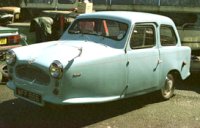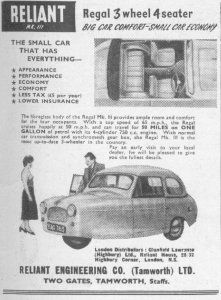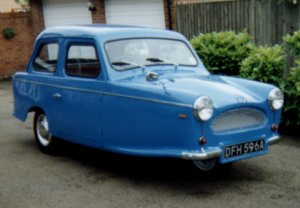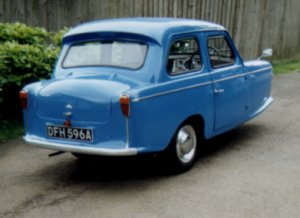 And what a car it was. A 1959 Reliant Regal Mk III, perhaps the single nastiest
piece of machinery ever made. This thing owed its existence to the difficulty of
gaining a driver’s license in England and to a quirk of English law that
defined a contraption called a “motor tricycle” that was taxed at a lower
rate and could be driven with a motorcycle license. To qualify it had to weigh
less than 896 pounds and, to get under the weight limit, much that you would
expect to be included (like a spare wheel) was an option or (like a heater) was
not available.
And what a car it was. A 1959 Reliant Regal Mk III, perhaps the single nastiest
piece of machinery ever made. This thing owed its existence to the difficulty of
gaining a driver’s license in England and to a quirk of English law that
defined a contraption called a “motor tricycle” that was taxed at a lower
rate and could be driven with a motorcycle license. To qualify it had to weigh
less than 896 pounds and, to get under the weight limit, much that you would
expect to be included (like a spare wheel) was an option or (like a heater) was
not available.
Well, I had my motorcycle license and, despite the fact that I had never driven a car, was legally permitted to drive a motor tricycle.
 It was already well
understood that you could build a pretty good three-wheeled car, if you put the
single wheel at the back, when the Reliant Motor Company decided to put the
single wheel at the front. They put it where the engine would conventionally be,
and pushed the engine back so that it sat between the front seat occupants and
drove rear wheels that were attached to a suspension that would be familiar to
farmers the world over. The engine was a long-obsolete pre-war Austin Seven
748cc side valve design that showed a great appetite for head gaskets (at least,
mine did). With an output of 14HP it was grossly over-powered for the
capabilities of the car, and may have been the last side-valve power ever
offered for sale in a car anywhere in the world. It had four seats, but with
four aboard it was extremely sluggish. This wasn't necessarily bad because you
didn’t want to go too fast – although it was advertised as having a top
speed of 50mph I only once got it up to 45mph, and it scared me so much that I
never drove it above 40mph again. The body was fiberglass (it was the first
production fiberglass body in England) with a thin plywood floor and the chassis
was an exceptionally simple box structure.
It was already well
understood that you could build a pretty good three-wheeled car, if you put the
single wheel at the back, when the Reliant Motor Company decided to put the
single wheel at the front. They put it where the engine would conventionally be,
and pushed the engine back so that it sat between the front seat occupants and
drove rear wheels that were attached to a suspension that would be familiar to
farmers the world over. The engine was a long-obsolete pre-war Austin Seven
748cc side valve design that showed a great appetite for head gaskets (at least,
mine did). With an output of 14HP it was grossly over-powered for the
capabilities of the car, and may have been the last side-valve power ever
offered for sale in a car anywhere in the world. It had four seats, but with
four aboard it was extremely sluggish. This wasn't necessarily bad because you
didn’t want to go too fast – although it was advertised as having a top
speed of 50mph I only once got it up to 45mph, and it scared me so much that I
never drove it above 40mph again. The body was fiberglass (it was the first
production fiberglass body in England) with a thin plywood floor and the chassis
was an exceptionally simple box structure.
Because I had never driven a car I had nothing to compare it with, so I just assumed that all cars were difficult to drive. It was delivered to the house by the seller, and driven forward up the driveway, so job number one was to find out how to make it go backwards. This took a while because it hadn’t occurred to me that you might have to pull the gear lever upward to select reverse. (I was lucky to have a reverse gear. The original definition of motor tricycle had specified that a reverse gear not be fitted.)
The first evening of learning how to drive a car was, um... "interesting".
It would be several months before I discovered that it wasn’t normal for the
engine to lift slightly when the clutch was depressed (engine mounts were shot)
and that the clutch was even less progressive than its inadequate best. It was
cold (no heater) and dark (lights even worse than the Lambretta). It was also
running badly (head gasket was blown -- a frequent occurrence) but all of this
was lost in the euphoria of one thing: I was driving A CAR. So what that
the windows slid horizontally so that you could only half-open them? It had
windows! So what that the inside door handle was a piece of bent metal? It had
doors!

 By the
next day I was beginning to get the hang of steering with a wheel (luckily, I'd
had plenty of practice with this on boats), and was getting quite confident by
the time I decided to bring it back up the driveway and found experimentally
that the gatepost was stronger than the passenger door handle and the fuel
filler. Luckily, it had no side mirrors even before the experiment.
By the
next day I was beginning to get the hang of steering with a wheel (luckily, I'd
had plenty of practice with this on boats), and was getting quite confident by
the time I decided to bring it back up the driveway and found experimentally
that the gatepost was stronger than the passenger door handle and the fuel
filler. Luckily, it had no side mirrors even before the experiment.
The best that can be said of this combination of bad vehicle and inadequate skills is that I never actually turned it over (this was a common thing to happen to a Reliant), but when I passed my test and had a real driver’s license it wasn’t long before the Reliant was history.